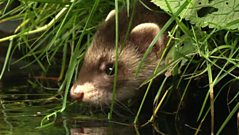
Life on the ledge
Guillemots are superbly designed for life at sea – they literally fly underwater. On land they're a little more ungainly. In April they come back to shore to nest on sea cliffs. They lay their eggs on bare rock. It is a very safe place to nest because land predators such as foxes and weasels can't get at them. But how on earth do they keep their eggs from falling off the cliff? Guillemots have evolved a conical egg, which swivels around its point when disturbed - unlike a hen's egg which would just roll straight off the rock. Simon demonstrates with a model egg. The nests are, however, vulnerable to attack from the air. Gulls patrol the cliffs looking for a weak link in the guillemot defences. They meet a line of pointed beaks to keep them away. Black-backed gulls muscle into the colony and use their size to manage to grab an egg. Herring gulls regularly mob the larger black-backs to dive them away, as they have their own nests to protect.
Duration:
This clip is from
Featured in...
![]()
�鶹�� Nature
Be captivated, informed and inspired by the world's wildlife.
More clips from Episode 9
-
![]()
Polecat sighting
Duration: 03:42
-
![]()
Tapping the parents
Duration: 01:20
-
![]()
Magical waters
Duration: 00:31
-
![]()
Dinner bell
Duration: 05:31
More clips from Springwatch
-
![]()
Hannah Stitfall discovers RSPB Arne's reptiles
Duration: 02:53
-
![]()
Hannah Stitfall goes behind the scenes on Springwatch
Duration: 01:18
-
![]()
Enjoy the calmness of a kelp forest
Duration: 01:11










